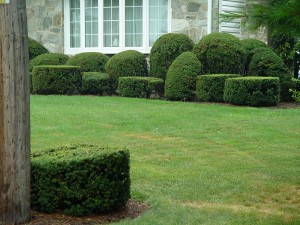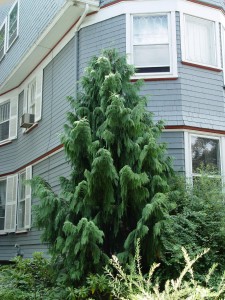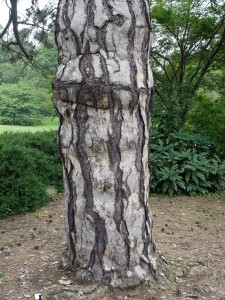Butchery in the Garden
July 7th, 2011
Richard Bitner makes a good argument that no plants take more abuse than the evergreens we plant around the house.
“Mulch and meatballs” is the look he calls it, referring to the yews that are so often chopped into little balls and boxes.
We not only over-use the same few species, we plant them in uber-boring and trouble-causing ways, Bitner suggests in his new book, “Designing with Conifers” (Timber Press, $34.95 hardcover, 2011).
“All too often, fast-growing selections are planted too close to structures and to one another,” he says. “They soon block windows and hang over driveways, and the owner is forced to butcher them.”
Drive down any central-Pennsylvania development and it’s hard to argue with that.
Bitner, a Hershey Medical Center anesthesiologist when he’s not writing about plants, thinks it’s high time we give more respect to conifers.
If you’re not familiar with the term, conifers are simply plants that produce cones. They’re by and large needled evergreens, although a few drop their needles in fall (dawn redwood, larch, baldcypress) and at least one (ginkgo) has leaves, not needles.
Bitner makes the point that conifers offer plenty of interest when it comes to color, versatility, shape, foliage texture and even bark.
The average person just isn’t aware of what all is available.
Beyond the ubiquitous yews, arborvitae and blue spruce, little else from this large plant family shows up in our landscape.
Which is a shame, Bitner writes, because “generally speaking, conifers are not finicky garden plants.”
Planted in suitable spots, they deliver what most homeowners say they want in a plant – little maintenance, toughness in drought and four-season interest.
Bitner’s book – his third on conifers – focuses on ways we can make much better use of conifers in a typical home landscape.
Around the foundation is just one of the ways.
On that front, Bitner offers many more choices than the common yew – especially dwarf ones that stay in scale without any pruning and that offer more interesting and more natural forms.
Two examples: the Hinoki falsecypress ‘Kosteri,’ a classy dark-green, 5-by-4-foot upright with a slightly twisted habit, and a globe arborvitae called ‘Whipcord’ that looks like an exploding mound of shaggy goldish-green yarn.
Cascading conifers such as the weeping Alaska-cedar and ‘Tolleson’s Weeping’ juniper make great specimen or accent plants in key spots, Bitner says.
And others poke up like columns to soften bare walls in skinny areas (Japanese plum yew ‘Fastigiata,’ juniper ‘Gold Cone,’ dwarf Alberta spruce ‘Jean’s Dilly’) or hug the ground to give a low-care alternative to turfgrass (juniper ‘Mother Lode,’ Siberian cypress, Japanese plum yew ‘Prostrata’). (Click here for more details, photos and care tips on these and other great conifers.)
Conifers aren’t just for around the house either, Bitner writes.
He says property borders and island gardens are often better spots where conifers can stretch out without ever needing a haircut.
Arguably their best use is in screening and serving as windbreaks.
Upright conifers make some of the fastest-growing and densest plants for blocking out unwanted views and for giving privacy – often a top goal in new subdivisions.
Planted to the north and west of homes, a line of evergreens does a great job of blocking cold winter wind from that prevailing direction.
While arborvitae are widely used (and over-used) for screening and windbreaks, Bitner offers many other great choices, including cryptomeria, Leyland and Lawson falsecypresses, upright junipers and incense cedar.
Similarly, upright conifers can act as “walls” to divide a yard into smaller rooms. They can be trimmed neatly for a more formal look or mixed and left au naturel for a more “gardeny” look.
This family offers way more than just green uprights, though.
Bitner’s book devotes an entire section to conifers of different colors, ranging from the golds of falsecypress, juniper and pine to the blue/grays of cedar, spruce and fir to conifers that actually change color in fall, such as the beautiful rusty orange of dawn redwood’s fall needles and the brilliant fall gold of larch.
Look close and you’ll even notice that some conifers have great bark. The flaking bark of lacebark pine and the shreddy, russet bark of dawn redwood are two of the nicest, while mature Austrian pines look like they’re wearing a zoot suit.
So with that kind of variety, why do we stick with yew meatballs?
Bitner believes most of it is a throwback to Victorian days when people wanted to hide their ugly, exposed lower foundations.
But now that vinyl siding, brick or stone often go the whole way to the ground, that reason is long gone.
Probably more at work lately is that people tend to plant what they know, and what they know is what they see everywhere else.
“It’s time to use conifers in more creative ways,” says Bitner.
Some other helpful plant suggestions from Richard Bitner’s new “Designing with Conifers:”
- Bitner’s picks for the four most under-used landscape conifers: incense cedar (a narrow upright); Alaska-cedar (upright with soft green needles and a weeping version); Japanese plum yew (a yew look-alike that deer don’t like in upright and spreading forms), and Siberian cypress (a shade-tolerant spreader that grows in layered waves).
- Some of the best choices for shadier spots: Japanese plum yew, Hinoki falsecypress, cryptomeria, Siberian cypress, yew, arborvitae.
- Conifers deer usually don’t eat: fir, cedar, Alaska-cedar, Hinoki falsecypress, Atlantic white cedar, cryptomeria, Leyland cypress, Western arborvitae, hemlock.
- Conifers that tolerate wet spots: Atlantic white cedar, American larch, dawn redwood, bald-cypress.










